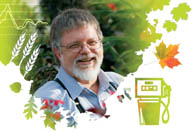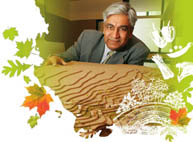McGill researchers confront the world’s challenge of living with limited resources\
By Mark Reynolds

The country has just emerged from the warmest winter on record, according to Environment Canada. With temperatures nearly four degrees above normal averages, it marks the highest temperature spike experienced in any season—spring, fall or summer. Winter 2005–06 joins a parade of eight years of higher-than-average temperatures in Canada.
None of that is proof of global warming, but it is one more frightening piece of evidence that the world’s population is going to have to learn to live within the means of a planet that might not look quite the same in a few decades.
Here at McGill, researchers are confronting one of the greatest challenges facing the world today: how to live sustainably on a planet with limited resources, where our activities and industry can have far-reaching and unforeseeable effects on the climate and environment. And while researchers might differ in the details, they are in full agreement that solving the problem will mean examining our policies, reinventing technology and even rethinking how and where we live.
Sustainability—the ability to reduce inequality and provide for our needs without leaving future generations unable to provide for theirs—is a growing concern of scientists, academics, politicians, business executives and others across the globe. This recognition of the scope of the problem is reflected at McGill, where environmental research is fast becoming the Green Giant on the University’s two campuses, whether through the study of how forests react to ecological pressures or through helping developing countries absorb the masses of rural poor flooding their cities.
Much of the effort is aimed at rising global temperatures caused by greenhouse gases, summed up as climate change, three syllables which promise a variety of ills including melting polar ice caps, flooding in some areas, widespread drought in others and wholesale ecosystem change worldwide. Some of the largest sources of these gases are the industry, transport and power plants that define life in the developed world.
The single biggest initiative to prevent this global transformation is the United Nations Framework Convention on Climate Change, known as the Kyoto accord. The Kyoto accord commits signatory countries to reducing emissions of gases like carbon dioxide and methane. The protocol has been widely criticized as ineffective for many reasons, only one of which is the failure of the world’s biggest greenhouse gas emitter—the United States—to ratify the treaty.
Tilting at Windmills

The critics might have the right idea, according to McGill economist Chris Green, who says that while there is a general consensus on the nature and rate of climate change and its causes, there is far less agreement on what it will take to put the genie back in the bottle. Green is interested in the technological and economic ramifications of pursuing various solutions to “stabilizing climate.” He started as a public finance and industrial organization economist, but in the late 1980s his work began to move toward the economics and technology of mitigating climate change when the then chair of economics asked him to represent the department at a climate change talk organized by the Department of Atmospheric and Oceanic Sciences.
Intrigued by what was happening in the field, Green became a charter member of McGill’s Centre for Climate and Global Change Research, which has now been transformed into the Global Environmental and Climate Change Centre, funded in part by the Fonds québécois de la recherche sur la nature et les technologies. Not all of what he has to say is welcome to environmental activists.
“What many activists are saying is that it wouldn’t be difficult to limit emissions sufficiently to stabilize climate. I think that this is terribly wrong,” he says.
Green argues that many existing technologies, like solar or wind power, are simply not reliable enough to produce the large-scale energy supply to displace fossil fuels. “We know how to catch solar and wind, but until we have a way of storing them on a large scale, their direct and intermittent delivery to the grid in significant amounts would produce blackouts. In effect, the cure would be viewed as worse than the disease,” he says.
Solutions like the Kyoto accord, which sets a deadline for countries to meet emissions reduction targets, are actually a part of the problem, according to Green. To meet their targets, countries are forced to put resources into short-term approaches that have little impact on a problem of this scale.
“We send Rick Mercer out to promote the One Tonne Challenge (to reduce personal energy use),” says Green. “How anyone can take this seriously, I don’t know.”
A better approach, according to Green, is to research and develop innovations that, although less predictable in time and outcome, would in the long term make alternative energy sources viable. Currently, solar, wind and the large-scale use of biofuels like ethanol are problematic. Nuclear can contribute, but its large-scale expansion faces a variety of limitations that will require some technological breakthroughs.
“Biomass is being hyped beyond belief—it gets a tremendous amount of attention because it supports agriculture and sounds so green. But unless you can reduce the energy input in producing the fuel itself, there are little or no energy savings.”
The Engine of Change

Plant science professor Don Smith is well aware of the limitations of biofuels, but his approach to solving the problem is close to Green’s prescriptions. As leader of a national plant sciences network, Smith is coordinating the work of 55 researchers from 13 universities. Sponsored by BIOCAP Canada, a foundation funded by the Natural Sciences and Engineering Research Council and other federal agencies, provincial governments and industry partners, the network has a goal of researching ways to reduce greenhouse gas emissions from agricultural activities.
Smith describes this work as “upstream” from the Kyoto accord. In other words, where Kyoto focuses on reducing greenhouse gas emissions at the end of industrial or energy production, his work is looking to find ways to reduce them at the beginning: from the production of the fuel itself.
As a result, Smith’s laptop is full of graphs and facts that would be more in keeping with an oil company executive than a plant science expert. His charts show that global production of petroleum fuel is peaking now, and it is unlikely that new reserves will reverse what will soon become a downward trend. Alternative fuels are therefore not simply ecological good sense—their development will be key to maintaining our economic well-being.
Already, biofuels are seeing more use in industrial countries, which Smith points out is actually a back to the future scenario: the first diesel engine and early Ford cars were designed to run on peanut oil and ethanol, respectively. But now, the energy input to create such biofuels as ethanol can be too high to make it a viable alternative.
Although Smith is optimistic about the potential benefits of biofuels, given current technologies and attitudes towards energy consumption, there are limits to what can be achieved. “If you covered all of the area of Europe with these crops, you’d only provide about half of the total energy needs the continent currently gets from fossil fuels—there’s only so far you can go with this,” he says.
New biofuel technologies are only a part of what Smith and his colleagues hope to accomplish to help Canada meet its emissions-reduction targets. Agriculture is a major source of greenhouse gases, from plowing, fertilizers and even some of the crops themselves. For Smith, this represents a potential area to make a significant dent in our emissions.
“We’re a northern country, so we produce a lot of greenhouse gases for heating, transport and the like, and something in the order of 10 per cent of that comes from agriculture,” says Smith. “With about half a per cent of the world’s population but huge amounts of agricultural land, we have this interesting opportunity in Canada.”
Smith says that Canada has released one billion tonnes of carbon into the atmosphere from soil tillage, much of that in the last hundred years. He hopes to address the problem by exploring creative approaches to crop use. Through genetic manipulation and breeding, crop varieties that require less fertilizer and trap more greenhouse gases in the soil—and therefore out of the atmosphere—could be developed.
“When you push plants, you can go a long way,” says Smith.
Branching Out

While Smith works on ways to adapt plants to our ends, natural resource sciences professor Jim Fyles is looking at how plants adapt to change in their own environment. Fyles’s office is only a short walk down the hall from Smith’s, but his research is several hundred kilometres removed from the agricultural fields that are Smith’s concern.
As scientific director of Canada’s Sustainable Forest Management (SFM) network, a federally funded Network of Centres of Excellence, Fyles is at the heart of a collaborative research and knowledge exchange effort involving government, industry, academics, NGOs and First Nations, who are partners in the funding, planning and execution of the network’s research.
“The complexity of the problem needs different voices and approaches,” says Fyles. When the opportunity to become scientific director of the SFM came up, he took up the challenge, partly because of his experiences working at McGill’s School of Environment, where professors from different faculties bring their own perspectives to collaborate on environmental questions. With stakeholders from so many groups, the SFM network provides a similar experience.
“The whole thing is fascinating, because it’s constantly crossing cultures—between aboriginal and ‘Western’ societies, across regions, sectors and disciplines, between provinces and the federal government,” he says.
Fyles’s research focuses on the boreal forests of northern Quebec, which he sees as the canary in the climate change coal mine. “Some of the biggest stretches of untracked wilderness in the world remain in Canada in the boreal forest,” he says. “And it’s this forest that is going to see the greatest impact from climate change.”
Understanding the complex ecology of Canada’s woodlands is important to all Canadians who work and play in the sylvan wilderness, and the flora and fauna for which it is home. From an industry point of view, how the boreal forest responds to ecological pressure—whether clear-cutting, fires or insects—could have huge ramifications.
More than 350 communities in Canada are directly dependent on boreal forests. According to Fyles, Quebec and Ontario drew a line in the muskeg several years ago, barring forestry activity above a set latitude in their northern forests, a ban that might not be strictly necessary if forests respond differently to disruption than is assumed. Opening up the North could be a boon for forestry—if we understand how the forest will respond to what is proving to be a complicated process of change.
The predominance of black spruce in the boreal forest over more southern varieties of trees like aspen had been attributed to subtle temperature differences: black spruce likes it cold; aspen prefers slightly higher temperatures. But Fyles has found that temperature is only part of the story—spruce thrives because of a blanket of sphagnum moss.
“If you had a fire that burnt right back down to mineral soil, you’d probably have an equal chance of aspen or black spruce establishing themselves,” he explains. “But if the sphagnum moss comes in first, it produces this thick organic matter that insulates the soil and is very acidic”—conditions the aspen hates. When the boreal forest and its sphagnum moss are disrupted by logging roads, the aspen will follow the new tracks far into the North, flourishing alongside the black spruce. This suggests that we will have to look a lot harder to see the forest for the trees.
“We’re finding the response of the ecosystem to climate change is way more complex than a simple ‘It’s colder up there,'” he says. Fyles suspects climate will play an important role, but not just on the trees. An increasingly warmer northern climate will cause organic matter to decompose faster, meaning it will insulate the soil less, which will in turn retain less water. Fire patterns will change as a result. Fyles says fires—more than temperature or even logging—are the greatest ecological driver in the boreal system. This will have a large effect on the forest ecosystem. Small changes in climate, acting on a complex system, may lead to large changes in the landscape.
Garden City

While Western governments juggle the political and policy dilemmas of protecting future economic growth without destroying the Earth’s ecological balance, the developing world is struggling with more basic questions of how to sustain life now. Worldwide, the number of people living in cities has increased to 47 per cent from 14 per cent a century ago. Much of this migration has happened in poorer countries that lack the infrastructure to cope with these new arrivals, many of whom end up in shanty towns, which lack such basic services as sewage and water systems.
Vikram Bhatt is developing a solution to help cities cope with the myriad problems associated with such poor neighbourhoods while allowing residents to create their own wealth.
Called “Making the Edible Urban Landscape,” Bhatt’s project is associated with the School of Architecture’s Minimum Cost Housing Group, and has participants from both Architecture and the McGill School of Environment, as well as the Resource Centres on Urban Agriculture and Food Security in the Netherlands. The International Development Research Centre and the United Nations Human Settlements Programme (UN-HABITAT) Urban Management Programme funded the project, which is working with cities in Asia, Africa and South America to develop neighbourhoods and upgrade existing squatter settlements to incorporate small-scale agriculture so residents can grow some of their own food and sell the surplus.
“Cities need not just be places of consumption. Why ship vegetables thousands of kilometres when we can grow a lot of them here?” says Bhatt. Working with UN-HABITAT, he solicited applications from cities around the world that demonstrated a commitment to the project. Colombo (Sri Lanka), Rosario (Argentina) and Kampala (Uganda) were selected.
In conjunction with local officials and residents, graduate students developed designs for the different challenges faced by the three neighbourhoods. While the shantytown in Colombo was established decades ago, the area in Kampala is a former brickyard that the local government now wants to make habitable. The Rosario neighbourhood is scheduled for major infrastructure upgrades that will change the face of the current development.
Each required a very different approach to incorporate Bhatt’s ideas of an “edible landscape.” Kampala is working on plans to use the non-potable water that has collected in the former brickyard’s trenches for irrigation, while the cramped alleys of Colombo will require rooftop or wall-based gardens suspended on trellises.
“Our belief is that people are already engaged willy-nilly in growing, so why not integrate it into design?” says Bhatt. “In the scriptures, Paradise was a garden, and a good neighbourhood should be like that—flowers, greenery and fruits.”
For more information on climate change research at McGill please see the McGill Reporter: www.mcgill.ca/reporter/35/09/c2gcr/
